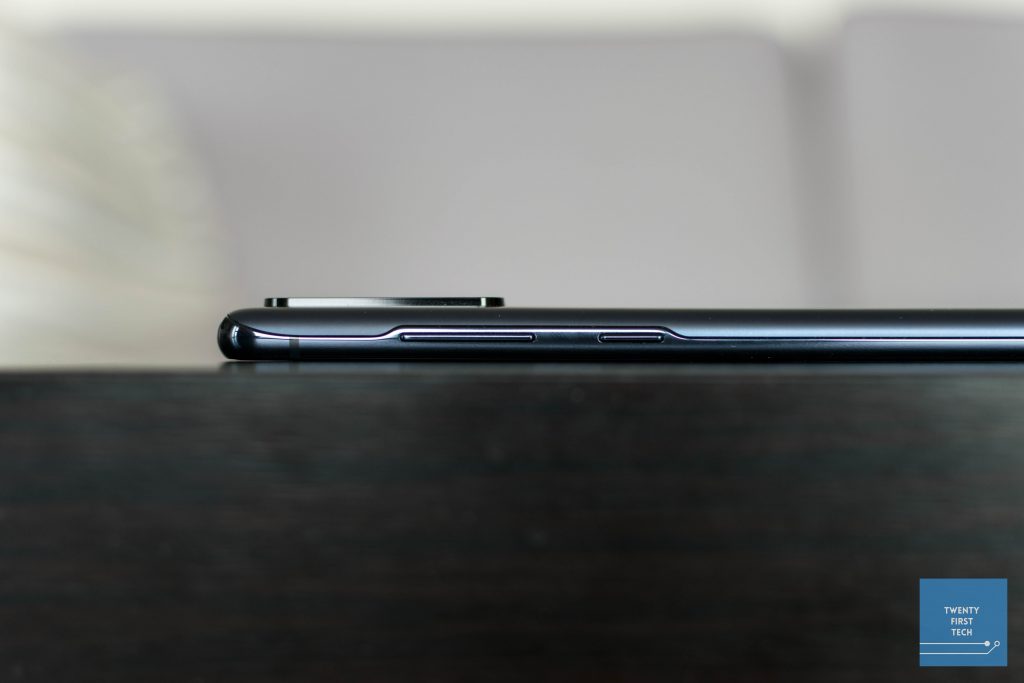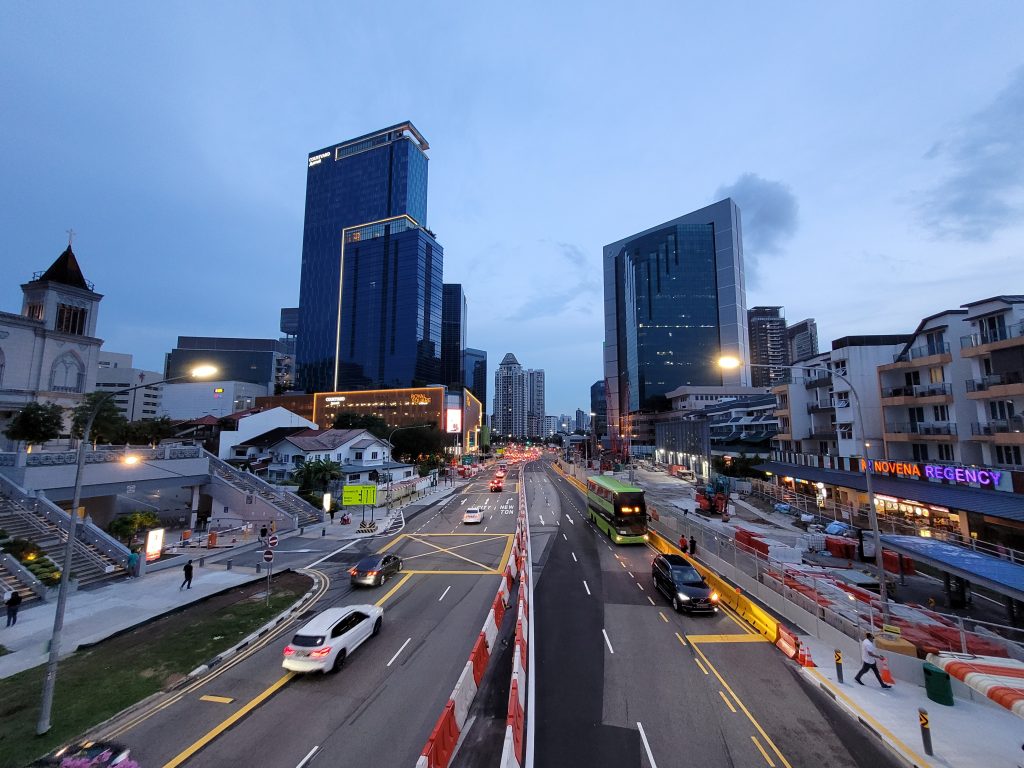Our Samsung Galaxy S20 FE review.
The Galaxy S20 FE 5G is Samsung’s attempt at producing a flagship killer. The premise is simple: flagship internals wrapped in a plastic body at a lower price. Throw in some fun colours and we have a strategy that’s reminiscent of the iPhone 5c from 2013.
But how’s the execution? Let’s find out, starting off with the specs.
Samsung Galaxy S20 FE 5G Specifications
- 159.8 x 74.5 x 8.4 mm, 190g
- IP68 water resistant
- 1080 x 2400 pixels, 20:9 (~407 ppi) 120Hz Super AMOLED, HDR10+
- Snapdragon 865
- 128GB/8GB RAM (S$1,098), 256GB/8GB RAM (S$1,168), UFS3.1
- Rear cameras: 12MP f/1.8 26mm wide, 12MP f/2.2 13mm ultrawide, 8MP f/2.4 76mm 3x telephoto
- Selfie: 32MP f/2.2 26mm
- 4,500mAh battery, USB PD 3.0, up to 25W fast charging (15W charger in box), 15W fast wireless charging, 4.5W reverse wireless charging
- Connectivity: 5G, Bluetooth 5.0, NFC
- Misc: stereo speakers, no headphone jack, under-display optical fingerprint reader
- Colours: Lavender, Mint, Navy, White, Red, Orange
Design & build
With the FE, the design and build is where the most compromises were made. In order to keep costs down, the FE comes with a fully plastic build instead of the more premium glass-and-metal builds found on its S20 cousins.
Unfortunately, the choice of materials is noticeable from the moment you pick up the phone. You really do feel the plastic construction; it just feels cheaper than other flagships.
Don’t get me wrong, polycarbonate, when done right, can feel really good. The Pixel 4a is an excellent example — despite being plastic, it never feels hollow, and the buttons are tactile and a joy to press. The same can’t be said for the FE. There is a very slight wobble to the plastic buttons, and while Samsung has done much to make the rim and back look like metal and glass respectively, no one will be fooled upon picking up the device.

Furthermore, the usual benefit of having a plastic build — being more lightweight — isn’t here. The FE weighs in at a hefty 190g. That’s heavier than my OnePlus 6T (185g) and even the OnePlus 8T which I am also reviewing (188g), despite the latter devices having a glass and metal construction. The heft is noticeable and your hand will feel tired after holding this phone for an extensive period of time.
Build quality aside, the design is standard for a 2020 flagship. There’s a left-justified camera array on the back with a camera bump. On the front you have relatively narrow bezels and a hole-punch selfie camera in the centre. More on that in the following section.
Overall, I think the build is fine. The IP68 water resistance is a nice inclusion. But I do wish that Samsung invested in better quality polycarbonate, and that the device was a lot lighter.
Display
The display is a 120Hz 1080p AMOLED panel. That’s the same refresh rate as the vanilla S20 series, but at a lower resolution. Then again if you note the fact that you can’t toggle both 1440p and 120Hz on the vanilla S20, the lower resolution of the FE is looking like less of an issue.
The AMOLED panel on the FE is good. It has the excellent colour accuracy and contrast that you come to expect from Samsung. The phone gets bright outdoors, but I noted that the maximum brightness lowers when the phone gets hot. This is a problem because in sunny Singapore, that happens all the time when you’re outdoors. On many occasions I found myself struggling to view the contents on my screen because the phone refuses to push the maximum brightness because it’s too hot.
The 120Hz however, is a game changer. This is actually the first phone that I’ve used with 120Hz (yes, I know I’m rather late to the party); the highest refresh that I’ve used prior to this was the 90Hz found on the Realme 6 and Realme 6 Pro. When I reviewed those phones, it was easy for me to go back to my 60Hz OnePlus 6T; I hardly noticed a difference. However, after using the 120Hz S20 FE for a couple of days, 60Hz phones feel downright laggy to me.
Honestly. I went into an Apple store to check out the new (60Hz) iPhone 12, and it felt so sluggish I thought there was something wrong with the unit that I was using. I went back to my OnePlus 6T, which I considered to be very snappy prior to this review, and now it just feels like it’s struggling to even render scrolling animations. Thanks Samsung, my daily driver feels so slow now.

The only issue is that the phone doesn’t seem to be running at 120Hz all the time. Pokemon Go for instance only ran at 120Hz on one occasion, while the rest of the time it seemed to run at a choppy 30 or 60Hz. I’m not sure how or when Samsung decides to throttle the display; perhaps it’s got something to do with the battery or heat management?
I do also have some gripes with the design of the display. It’s the subtle things like the curvature of the corners of the display not matching the curvature of the corners of the phone itself. Or the selfie camera having a strange reflective (asymmetrical!) ring around it. The latter one bugged me the most. Hole punches are prominent enough as they are. Samsung went ahead and made it more prominent. It’s almost as though they did this to make the phone to feel cheaper than its flagship counterparts.
It’s not just the ring too. In software, Samsung blacks out the pixels surrounding the selfie camera when that camera is in use, making the selfie camera look even larger than it already is. It’s a peculiar design decision which I personally dislike.
Performance
The unit that I have is a 128/6GB RAM unit. The retail units are 128/8GB and 256/8GB. That mostly just means that the units that Singaporean consumers receive will be able to keep more apps in memory than my review unit.
You already know that performance on this device is going to be excellent thanks to the S865 chip. Interestingly, in Singapore, the S20, S20+ and S20 Ultra run on Samsung’s Exynos 990 chip. This means there is actually a performance difference between the FE and the rest of its cousins. Simply put, the Snapdragon has slightly better CPU performance and battery life while Exynos has better graphics. That’s something to consider when choosing between the SE and the regular S20.
Anyway, here are some synthetic benchmarks. You can see that it stands toe-to-toe with the newly released OnePlus 8T.


Camera
Samsung hasn’t skimped on the cameras either. While only the main sensor remains the same compared to the regular S20, image quality doesn’t disappoint. Here are some camera samples.
I was impressed with the consistency across the three cameras. Dynamic range is excellent across the board, as is detail and colours. I did find the saturation to be a bit much, especially in the sky; but some people like Samsung’s signature look. The 3x optical zoom provided by the telephoto allows for some detailed zoom shots.
Samsung’s got a portrait mode called live focus that works great too, even on non-human subjects. You can even adjust the blur focus after capturing the photo.

There’s also a dedicated night mode that performs well, though I did not test it extensively. Overall, I’m very pleased with the image quality on all three of the S20 FE’s cameras. They are some of the best cameras that I have seen this year and will not disappoint.
Software & battery life
Software is Samsung’s One UI that’s been more or less the same since the Galaxy S8. It’s clean and generally pleasant to use. There’s also Samsung-specific features like an always-on display and the side panel for quickly launching apps. Bixby is here too, though they’ve thankfully made it easy to ignore with some tweaks in the settings.
The main gripe with the software is that it ships with Android 10 and not Android 11, despite the newer OS being around for a couple of months now. The FE will be updated to Android 11 eventually though. In fact, Samsung has recently committed to 3 years of Android OS updates. That’s good news, though it remains to be seen how quickly Samsung will push out these updates.
The fingerprint reader, being optical and under-display, isn’t very good. It doesn’t work a lot of the time, which was rather frustrating. I wish manufacturers will follow Google in reviving the capacitive readers; those are far more reliable.
Battery life is good but not spectacular. I’ve been getting around 4-5 hours of screen on time with the FE which typically lasts me till the end of the day unless I game. Charging speed is where it’s disappointing. Despite supporting 25W charging, a 15W charger is included in the box. (In fact, it’s the only thing that’s included in the box other than the phone.) It takes about an hour and a half to get the battery fully charged, which, compared to the likes of the OnePlus 8T for example, is rather slow.
I’ve also noticed that the battery hardly charges at all if you’re using it while it’s charging. The phone gets hot too. This isn’t an issue with say, OnePlus phones.
There’s also reverse wireless charging so you’ll be able to charge say, your Galaxy Buds with these. I unfortunately forgot to test this feature with my own Buds+ as it completely slipped my mind.
Pricing & conclusion
Pros
- Excellent performance with S865 chip
- 5G-ready
- Excellent triple camera setup
- Good battery life
- Great 120Hz display
Cons
- Build feels cheap, yet phone is heavy
- Under-display fingerprint reader is rather inaccurate
- Still pretty pricey in Singapore
I think the S20 FE is exactly what Samsung wanted to be: a lower cost addition to the S20 lineup, due only to its plastic construction. But the price is where things get tricky. In Singapore, the regular S20 is currently going for S$998, that’s cheaper than the S$1,098 that the FE is going for the same storage configuration. At that price point, I don’t see why one wouldn’t go for the regular S20: it’s got a much better build and a higher resolution screen.
Sure, there are discounts. Samsung is currently offering the 256GB model at the price of the 128GB one, and the 128GB one is discounted to S$998. But then you look at something like the OnePlus 8T, which also has 8/128GB and a 120Hz AMOLED display, but goes for S$899. Sure, the OnePlus does not have an official IP rating (though it is still water resistant), wireless charging, or a telephoto camera, but it does have much faster 65W charging (vs 15W) and OxygenOS running the more up-to-date Android 11.
If you’re willing to look past the inferior build, and if you can snag one at a discount, the S20 FE is a good choice. Otherwise, Samsung’s own offerings and the OnePlus 8T are compelling alternatives.
As always, when purchasing online, check if you can get additional cashback on your purchase with ShopBack. You can also check out our deals page for more Singapore deals.
Liked this review? Follow us on Facebook, Twitter or Instagram for more updates!














I found your article to be a refreshing take on the subject. If you’re interested in exploring alternative perspectives, click here for a thought-provoking discussion.